 | |||
 | |||
BRAZIL NUTS - A Complete Guide
Where do Brazil nuts come from?
Most of the world's supply of Brazil nuts comes from South America.
Brazil nuts grow in Brazil, as well as Bolivia, Peru, Colombia, Venezuela
and the
Guianas.
What does the Brazil nut tree look like?
The Brazil nut tree is a beautiful, tall evergreen tree which towers over the
other plants in the forest where it grows. It has a long, straight trunk,
with a diameter of four to eight feet. Branches appear only on the top part
of the tree. Sometimes a Brazil nut tree can reach a height of one hundred
and fifty feet, though most are about one hundred feet tall. The branches
can have a spread of one hundred feet or more.
The leaves of the Brazil nut tree are dark green and shiny, measuring twelve
to fifteen inches in length and six inches in width. Its flowers are pale yellow.
When the Brazil nut fruit is mature it measures four to six inches in diameter,
and weighs from two to four pounds, not unlike a large coconut.
A good annual yield from an individual tree ranges from two hundred and fifty to five hundred pounds of unshelled nuts. However, after such a successful yield, the following year can be expected to result in a poor yield.
What are some historical references to the Brazil Nut?
In 1569 a Spanish official, by the name of Juan Alvarez Maldonado, came across
some Brazil nut trees in a small village in Peru. The local Indians told
him that there were more of these trees growing nearby. Maldonado commanded
his troops to gather thousands of the nutritious nuts for food.
In 1633, Dutch traders in Brazil sent a small quantity of "wild oil fruits" to
the Netherlands. We may safely assume that these were, in fact, Brazil nuts.
In the 1700's numerous shipments of Brazil nuts were sent off to Europe.
Larger quantities began to be shipped to Europe in 1818. Since they originated in Para, they were known as "Para nuts". In 1866 the Amazon river was opened up to foreign trade. This had a dramatic impact on subsequent export of Brazil nuts, which increased impressively.
Does the United States import Brazil Nuts?
Yes, it does, going back to 1810, when some Brazil nuts were included in a
shipment of rubber, cocoa and cashews from Brazil to New York.
Between July 1, 1872 and June 30, 1873 almost four million pounds of unshelled
Brazil nuts were imported by the United States, as documented by customs records.
At that time the price was just over 4¢ a pound, holding steady until
World War II. By 1982, unshelled Brazil nuts were selling in New York for $1.40
a pound, while the quantity of both shelled and unshelled nuts imported into
the United States increased sevenfold over that of 1873.
How are Brazil Nuts harvested?
Since Brazil nut trees grow in the jungle, trails first have to be cut around
swamps and across streams for access. When the Brazil nut fruit is ripe, it
falls to the ground. But one has to watch out not to be hit on the head by
it, for the following two reasons: Its shell is prickly and each fruit weighs
two to four pounds, resembling a large coconut. Also, it falls from a height
of approximately one hundred feet or more. Thus, nut collection is a rather
dangerous job. Should one of these hard, heavy fruits come crashing down on
some poor, unsuspecting person's head, the result could be fatal.
The worker whose job it is to collect the Brazil nuts, gathers them in baskets
and brings them to his hut. Sometimes the shells are removed from the fruit
right in the jungle, saving the worker the job of carrying their extra weight
to his hut. In any case, the shell is split open with a knife. Each fruit contains
twelve to twenty-four Brazil nuts, closely packed together, with the thin edge
inward, like the sections of an orange.
How are Brazil Nuts processed?
Brazil nuts are first washed in a local stream. Then they are dried. Next,
they are carried by mules or transported by boat to the nearest trading post.
These days roads have been vastly improved so that many Brazil nuts are transported
by truck.
Brazil nuts are then graded by size, while still in the shell. 40-45 nuts
per pound are labeled Extra Large, 46-50 are Large, 51-56 are Weak Large,
57-62
are Medium "Tocs", and up to 110 nuts per pound are Small.
Because of the high temperature and humidity in the Amazon region of South
America, Brazil nuts are inclined to sweat, which can cause them
to get moldy. Therefore, they must be constantly turned over and aerated. Also,
the drier they are before shipping, the less chance there is of contamination
by mold. That is why today most Brazil nuts are first thoroughly dried in Brazil,
in some factories by modern drying machines and to precisely regulated moisture
content, before they are exported.
After drying, the unshelled Brazil nuts are checked over by hand, so that all
moldy, empty, cracked, and otherwise imperfect nuts are removed. Then they
are graded according to color, and packed in fifty-kilo sacks.
How are Brazil Nuts shelled?
First they are soaked in water for twenty-four hours. Then they are boiled
for five minutes to soften the shell, after which they are cracked mostly
by hand. The good nuts are dried and graded for quality and size. Imperfect
and broken kernels are not wasted; they are used in the extraction of Brazil
nut oil, an excellent cooking oil.
What are Brazil Nuts used for?
Brazil nuts can be eaten raw, roasted, or salted. They are used in ice cream,
baking and confections. They are an important ingredient in shelled nut mixtures.
Brazil nuts are a very healthy food, containing a high percentage of digestible
oil, protein and carbohydrates, as well as calcium, phosphorous, potassium
and Vitamin B.
How should Brazil Nuts be stored?
Because of their high fat content, Brazil nuts quickly become rancid when exposed
to air and light. Processing, such as blanching, slicing and chopping, speeds
up this effect. Therefore, it is better not to store them in this condition
for too long. But if Brazil nuts are properly dried and kept in a sealed
plastic or glass container, in a dark, cool place, they should keep fresh
for many months.

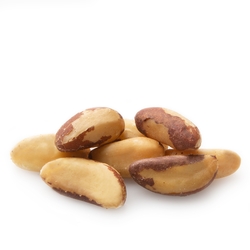



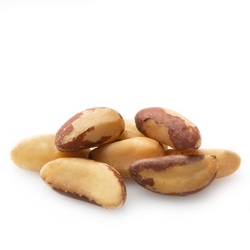
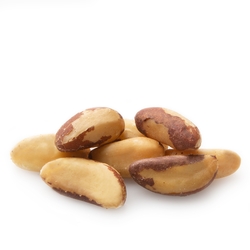
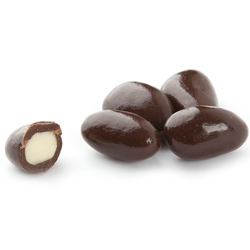
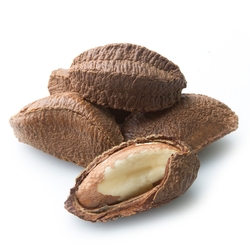

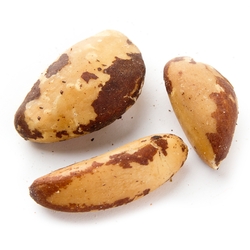
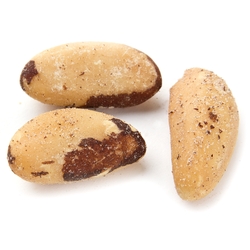
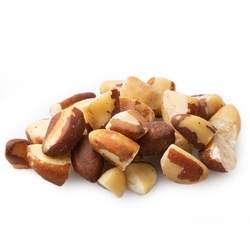
 or
or 
